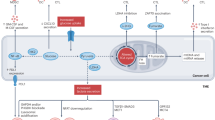Abstract
Photodynamic therapy (PDT) is an experimental approach to the treatment of neoplasms in which photosensitisers (PSs) accumulated in malignant tissues are photoactivated with appropriate wavelengths of light. The target specificity of PSs may be improved by linking them with carrier macromolecules such as monoclonal antibodies (MAbs). OC125 is a murine MAb that recognises the antigen CA 125, which is expressed on 80% of non-mucinous ovarian tumours. A chlorin derivative conjugated to OC125 was shown to be selectively phototoxic to ovarian cancer and other CA 125-positive cells in vitro and ex vivo. We now report in vivo studies using an ascitic Balb/c nude mouse ovarian cancer model. Ascites was induced by intraperitoneal injection of cells from the human ovarian cancer cell line NIH:OVCAR3. Six weeks after injection, when the animals had developed ascites, biodistribution studies were carried out by injecting the immunoconjugate (IC) or free PS intraperitoneally and sacrificing the animals at 3, 6, 12, 24, 48, 72 and 168 h later. The PS was quantitated by extraction and fluorescence spectroscopy. For both the IC and free PS, peak tumour concentrations were reached at 24 h; however, the absolute concentrations for the IC were always higher (2- to 3-fold) than the free PS. Tumour to non-tumour ratios at 24 h for the IC were 6.8 for blood, 6.5 for liver, 7.2 for kidney, 5.7 for skin and 3.5 for intestine. Evaluation of viable tumour cells in ascites following in vivo PDT with a single light exposure demonstrated a dose-dependent relationship with fluence and IC concentration. However, there was significant treatment-related toxicity at all fluences. With multiple low-dose treatments, the percentage of viable tumour cells was also significantly reduced and there were no treatment-related deaths. These data suggest that, while photoimmunotherapy remains promising as a new treatment modality for ovarian cancers, careful quantitative dosimetry of both IC and light may need to be combined with multiple treatments (as with radiation therapy and chemotherapy) to control malignant disease yet maintain acceptable toxicity in vivo.
This is a preview of subscription content, access via your institution
Access options
Subscribe to this journal
Receive 24 print issues and online access
$259.00 per year
only $10.79 per issue
Buy this article
- Purchase on Springer Link
- Instant access to full article PDF
Prices may be subject to local taxes which are calculated during checkout
Similar content being viewed by others
Author information
Authors and Affiliations
Rights and permissions
About this article
Cite this article
Goff, B., Hermanto, U., Rumbaugh, J. et al. Photoimmunotherapy and biodistribution with an OC125-chlorin immunoconjugate in an in vivo murine ovarian cancer model. Br J Cancer 70, 474–480 (1994). https://doi.org/10.1038/bjc.1994.330
Issue Date:
DOI: https://doi.org/10.1038/bjc.1994.330
This article is cited by
-
Cancer-targeted photoimmunotherapy induces antitumor immunity and can be augmented by anti-PD-1 therapy for durable anticancer responses in an immunologically active murine tumor model
Cancer Immunology, Immunotherapy (2023)
-
Enhanced photodyamic therapy via photosensitizer-loaded nanoparticles for cancer treatment
Journal of Pharmaceutical Investigation (2019)
-
Minimally-invasive debulking of ovarian cancer in the rat pelvis by means of photodynamic therapy using the pegylated photosensitizer PEG-m-THPC
British Journal of Cancer (1999)
-
Tumor labeling in vivo using cyanine-conjugated monoclonal antibodies
Cancer Immunology Immunotherapy (1995)



